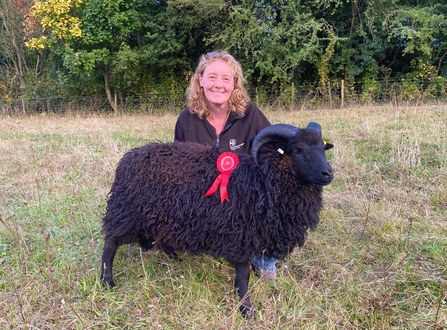
Agnes Kiemel, Livestock Officer with West Burton Barra, the winning Hebridean ram lamb at the 2024 Melton Mowbray Traditional and Native sheep show.

Agnes Kiemel, Livestock Officer with West Burton Barra, the winning Hebridean ram lamb at the 2024 Melton Mowbray Traditional and Native sheep show.
We highly value the Trust volunteers, in fact the organization would not be able to achieve what we achieve for nature without them, but we do also have some special animals that help with certain conservation grazing duties. The rare breed English Longhorns, Lincoln Red cattle, along with the Hebridean and Herdwick flocks of sheep do a great job clearing scrub on the reserves saving time and effort for our conservation volunteers to focus on more taxing duties, usually involving handheld tools instead!
The conservation grazing programme on our Nottinghamshire nature reserves is a year-round effort, and a key part of caring for our meadows. The cattle and sheep all prefer differing plants to eat, including grass and scrub, and each has their specialisms in grazing, whether it be cropped grass or birch removal. providing a great variety of habitats for wildlife. However, it is not just the grazing style that helps maintain the meadows in particular. This time of year, post meadow hay cut, after the wildflower seeds have fallen to the ground, the grazing team are on munching duties again in our meadows, but it is also their hooves that are doing the work too. Walking on the meadow, allowing the fallen seeds to be pressed into the soil ensuring contact for germination is a key service they provide.
Given that our rare breeds work so hard for nature we take great care of them and like to demonstrate how well they are doing by attending local livestock shows. All our livestock are halter trained for ease of management. That’s why you may sometimes see them on display at events such as at Idle Valley for visitors to view up close with staff and volunteers and help to understand why we maintain our herds and flocks for conservation grazing purposes. It’s a great experience for those not used to a rural farm life, of all ages and abilities.
The Livestock team recently attended the Melton Mowbray Traditional and Native sheep show and low and behold, yet again, we have a winner! Success like this shows the local farming community we are taking our responsibilities seriously - but equally highlights that our charitable aims benefit from wildlife friendly farming methods. The Livestock team, including Agnes Kiemel, the Trusts’ Livestock Officer, along with volunteers David and Charis took a total of 11 sheep; 2 ewe lambs, 6 shearling ewes, 2 shearling rams and 1 ram lamb. The 2 ewe lambs, 2 rams, 2 ewes and the ram lamb were all entered into the show to be professionally inspected and judged. It was a great result with two 4th prizes, three 6th prizes and our lovely ram lamb called West Burton Barra (after one of our small meadows) winning first prize!
It was decided not to cash in on the first prize accolade this time round and sell West Burton Barra because we felt he was worth more than the bidding on the day. As a charity it is important to ensure we make the most of our assets. So, it was decided to bring him back home and see how he develops and who knows we may enter him again next year.
Nottinghamshire Wildlife Trust were the highest sellers of Hebridean shearling ewes in this year’s sale - showcasing our support for the rare breed. Happily, the shearling rams were bought by Lancashire Wildlife Trust. Keeping them within the movement of Wildlife Trusts and making stronger new contacts with fellow Wildlife Trust teams.
The team stated they had “A very successful weekend and was very much enjoyed by us all.” I hope that included the sheep!